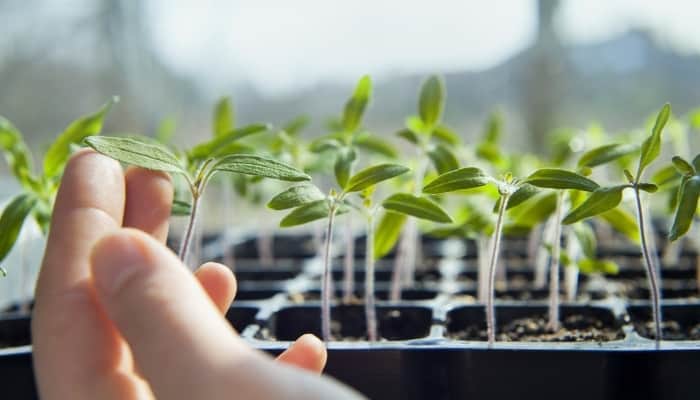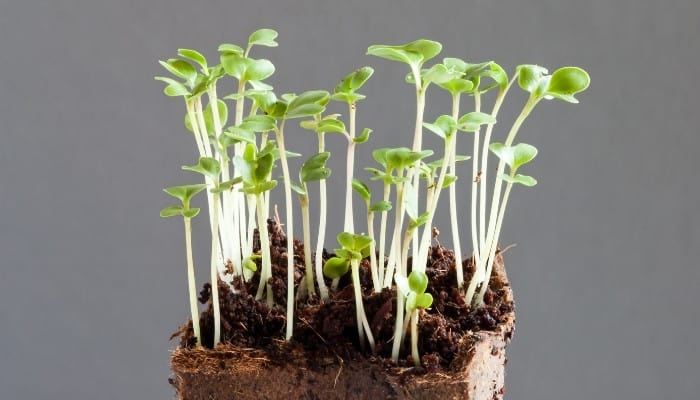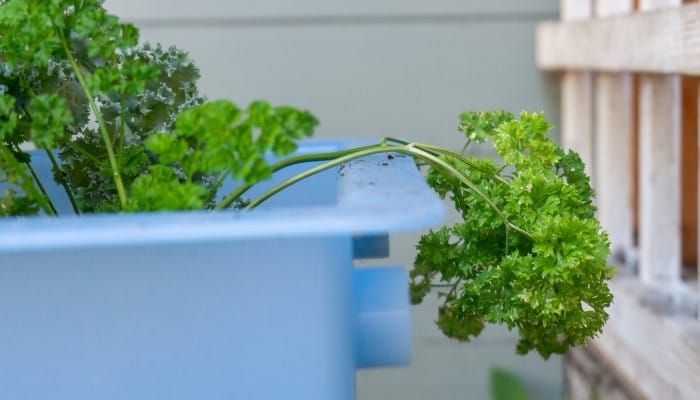It is not difficult to prevent leggy growth, as this guide will show you the importance of proper lighting for maintaining healthy plant growth.
That, combined with a little restraint when doling out the fertilizer and remembering to maintain a consistent watering regime, adds up to a happy, healthy plant.
What causes leggy plants? Insufficient nutrients and low light are primary cause of leggy plants. Other contributing factors are excessive growth, inadequate pruning, over-fertilizing, and poor plant health. Legginess is not a disease but does result in weakened seedlings and plants, which leads to fewer blooms or fruit.
This guide will discuss what it means for a plant to be leggy and how to resolve or avoid the situation at all costs.
Reasons Why Plants Become Leggy
As a keen gardener, you may already be familiar with dreaded leggy plants. For those who haven’t experienced this problem yet, let’s take a moment to clarify.
What exactly does it mean for a plant to be leggy?
The term “leggy” describes the growth and appearance of a plant with the following characteristics: spindly foliage, weakened growth, and minimal development of fruit or flowers.
For most gardeners, this is not the look or result they want to achieve, so a remedy or prevention plan is required.
Before we launch into how to resolve and prevent legginess, let’s first understand the causes.
Normal Growth Patterns
Growing conditions affect the growth patterns of all plants. If provided with adequate nutrient-rich soil and water, all plants grow at the correct pace.
However, in some cases, growing conditions are too perfect, resulting in excessive foliage that the immature roots and stem cannot support.
This results in leggy growth and weak seedlings or plants.
This can be very disappointing to gardeners who have put time and effort into their plants.
No one wants to see their precious tomato plants looking rather sickly without a tomato in sight or their broccoli looking less than green, full, and crunchy.
Inadequate Light
Low-light conditions prevent the plant from photosynthesizing and producing the glucose required for proper growth.
As a result, the plant’s leaves and stems stretch upwards, seeking additional light. This stretching is what gardeners call leggy growth.
To avoid this, place the plants or seedlings in a south-facing window or outside in the direct sun for six to eight hours each day.
(Confused about the terms direct light, indirect light, filtered light, shade, partial shade, and full sun? We sort it all out for you here.)
Alternatively, you can make use of a grow light to provide adequate lighting for seedlings and indoor plants.
If you don’t already have one, I recommend this model with dual lamps, three timer settings, and five light levels. The gooseneck style and simple clamp make it easy and convenient to use anywhere.
Nutrient Imbalance
Regularly fertilizing your plants in the growing season is recommended because a lack of nutrients can result in poor fruit and flower production as well as leggy growth.
However, over-fertilizing can also cause leggy growth.
Therefore, it’s best to use a diluted water-soluble fertilizer (like this one that’s perfect for both indoor and outdoor plants) to feed plants during the growing season.
If you are regularly fertilizing and notice leggy growth, you should stop applying fertilizer to allow the plant to recover.
Rapid Growth
Some fertilizers have high nitrogen levels, which encourage vigorous growth.
However, excess nitrogen can cause rapid growth, resulting in tall, spindly plants rather than developing natural girth.
Often tall spindly plants produce poor fruit and flower yields. In addition, rapid growth can weaken the plant, making it top-heavy, unable to support itself, and more susceptible to disease.
Lack of Pruning
All plants require pruning on some level to remove dead leaves or excessive foliage. Prune plants in early spring to avoid legginess and encourage thicker, sturdier stems and branches.
Pruning also removes leggy growth; this is essential for plant health.
If leggy stems are left to grow, the plant health deteriorates as it uses necessary growth nutrients to feed these weak stems rather than for healthy growth.
Thus, pruning encourages growth and improves plant health.
Can Leggy Plants Recover?
The good news is that you can help your leggy plant recover by providing adequate lighting, water, and nutrients.
By making simple adjustments, you can help your plant regain its health and luscious foliage. That said, not all leggy seedlings go on to be healthy mature plants.
The stress caused by legginess can impede development, consequently reducing the plants’ ability to produce.
The secret to curing leggy plants is to prevent them from becoming leggy in the first place.
How To Fix Leggy Plants
- Repot the plant using a deeper container so that part of the stem is buried in the soil. Some plants, like tomatoes, have hairs on their stems that can develop into roots.
- If planting outdoors, bury the stem deep in the soil; the soil will provide extra support for the stem and fresh nutrients.
- Increase the plants’ exposure to direct sunlight or use a grow light to ensure the plant can photosynthesize and produce enough food required for healthy growth.
- Maintain a good watering schedule and ensure the soil drains well.
- Stop fertilizing. Often the cause of legginess is due to over-fertilizing.
- Prune leggy foliage and remove dead and diseased leaves. This will improve airflow to lower leaves and stop the plant from providing nutrients to unhealthy vegetation.
How To Prevent Plants From Getting Leggy
- For indoor plants and seedlings, the use of a grow light will ensure the plant can produce the necessary sugars required for healthy growth.
- Outdoor plants should be planted in an area that receives adequate sunlight for at least six to eight hours of the day.
- Fertilize your plants regularly in the growing season with a balanced fertilizer and follow a good watering regimen.
- To encourage healthy growth, don’t forget to prune in the early spring and pinch off dead or diseased leaves regularly to promote bushier growth.
- Reduce the temperature. Overheating plants will encourage rapid growth, but they put up tall, skinny stems instead of pushing out new leaves.
- Increase watering. Lack of soil moisture prevents plants from drawing nutrients required for growth resulting in spindly growth and death.
- Space plants and seedlings evenly allowing for airflow and growth. Overcrowding plants will encourage tall spindly growth as they struggle for their share of nutrients.
Frequently Asked Questions About Leggy Plants

Leggy vs. Healthy Seedlings
Seedlings are pretty easy to grow but have particular requirements to keep them healthy and strong rather than leggy and weak.
Although leggy seedlings may eventually develop into mature plants, the stress they have experienced as tender seedlings can cause poor plant health, and often they are not as fruitful.
In contrast, a healthy seedling will develop into a healthy plant and, if provided with the right growing conditions, will be fruitful and less prone to disease.
What Causes Leggy Seedlings?
The leading cause of leggy seedlings is an insufficient light source. For example, if grown indoors on a windowsill, the light may be too low and too far away for the seedling to photosynthesize properly.
As a result, the seedling will grow tall and seem to stretch towards the light resulting in leggy seedlings.
In addition, over-fertilizing seedlings with nitrogen-rich fertilizer will result in excessive growth, but rather than producing healthy, robust seedlings, the plants are thin and leggy in appearance.
How Do You Fix Leggy Lettuce Seedlings?
Inadequate light conditions, overheating, and poor watering can all result in stringy lettuce seedlings.
Improve the lighting conditions with a grow light or place the seedling tray in direct sunlight for at least 12 hours a day.
Ensure the seedlings are not exposed to temperatures higher than 70℉. Use a heat mat to regulate temperatures, or move the tray to a partially shaded area for part of the day.
Ensure the seedlings have enough space between them to grow, and maintain a consistent watering routine. Transplant mature seedlings as soon as they are hardened.
How Do You Fix Leggy Tomato Seedlings?
Leggy tomato plants are relatively easy to resolve because the roots grow directly from the main plant stem.
Remove the bottom leaves and transplant the tomato plant into a new container. Ensure part of the stem is below the soil surface.
The plant will develop new roots while the stem will become thick and strong. Position the plants in full sun or under a grow light to provide adequate light.
For mature tomato plants, pinch off the top of the plant to encourage bushier, healthier growth.
How Do You Fix Leggy Broccoli Seedlings?

Broccoli seedlings demand a lot of bright light to remain healthy. Increase the light with a grow light or place them in a south-facing window to help with lighting conditions.
Alternatively, transplant the seedlings outdoors in a sunny area of the garden. Feed regularly with a fertilizer that is low in nitrogen but high in phosphorus (like this one) and water regularly.
For mature broccoli seedlings, prune the plant back to its original leaves and cover part of the stem with topsoil. Use a stake to stabilize the plant.
How Do You Fix Leggy Sunflower Seedlings?
Increase light levels with a grow light or place in a south-facing window. Sunflowers are nutrient thirsty and will require frequent feeding with a diluted balanced fertilizer.
Plant the leggy seedlings in a new container or, if hardened outdoors, ensure the stem is partially buried in the soil.
Provide the plant with lots of bright light and water. You may find you need to stake the sunflower as it grows due to its rapid growth rate.
How Do You Prune a Leggy Jade Plant?
Infrequent pruning can result in an overgrown leggy plant. The leggy sections drain healthy nutrients from the plant resulting in poor plant health.
Removing the stem tips will encourage thicker, bushier growth. Using a sharp pair of pruning shears, prune just above the leaf scar (brown stem ring) and snip off the growing tip.
Repeat the process as the plant grows. A lack of sunlight will cause increased leggy growth as the plant seeks additional light resulting in a less compact and full-bodied plant.
How Do You Fix Leggy Houseplants?
Houseplants are subjected to lower lighting levels than their outdoor counterparts and need to be positioned in areas that receive adequate light for growth.
Increasing light exposure by repositioning the plant or using a grow light can be beneficial.
In addition, pruning the long, leggy stems will encourage new shoots at the base of the plant and prevent the plant from losing nutrients to leggy foliage.
Feed the plant with a balanced fertilizer after pruning to promote new growth.
Another consideration for houseplants is that they may have become rootbound, resulting in leggy growth as they cannot draw the necessary nutrients from the soil.
Repot houseplants annually or when rootbound to prevent leggy growth.
How Do You Fix Leggy Marigolds?
Marigolds like space, bright light, moist potting mix, and regular fertilizing using a diluted balanced fertilizer.
If you are unlucky enough to end up with leggy marigolds, the first thing to address is the lighting.
- First, increase the plants’ exposure to light; marigolds require a minimum of six hours of sunlight each day.
- Next, check that the soil is moist but not soggy as marigolds tend to become leggy when overwatered.
- Reduce watering, and check the soil for moisture between each soaking.
- Finally, fertilize with a diluted but balanced fertilizer as too much fertilizer results in rapid growth, causing thin stems and weak foliage.
How Do You Fix Leggy Basil Plants?
Fixing a leggy basil plant is a three-step process.
- Firstly you need to prune the stems to allow additional light to reach lower leaves.
- Secondly, ensure the plant has good loamy soil to grow in; this will provide sufficient nutrients without the need for excessive fertilizing, another reason for leggy basil!
- Finally, potted basil should be repositioned in an area that receives full sun to increase fuller growth.
Alternatively, outdoor basil should be transplanted to a sunny location in the garden.
Basil requires a lot of water if grown in direct sunlight. Maintain a regular watering routine to ensure the soil remains moist and allows for sufficient nutrient uptake.
This will also help to prevent yellowing leaves, which we troubleshoot in this article.
How Do You Fix Leggy Roses?
Leggy roses produce fewer blooms on the lower stems, resulting in bare lower limbs and a tall, rather than round and bushy, appearance.
However, a simple technique called “notching” can help resolve the issue.
Carefully run your fingers along the stem until you feel a node. Then, using a sharp knife, slice into the bark approximately half an inch above the node.
The cut does not need to be very deep and should not remove the bark around the entire stem as this will cause the branch to die.
Notching will interrupt the flow of nutrients to the top of the rose bush forcing the plant to reawaken dormant buds for the next season.
Conclusion
Don’t feel alone should you be struggling with a leggy plant; we have all been there, and to be fair, it’s a fairly common occurrence when you’re in the business of growing plants!
Overall, the main takeaway when dealing with leggy plants is understanding that plants require adequate lighting, frequent pruning, and a balanced approach to fertilizing.
Although a leggy plant may cause concern for plant parents wanting the best for their plant family, it’s good to remember that a leggy plant can soon be back to its glorious leafy self with a few simple adjustments.
Remember, the equation for avoiding legginess is: light plus more light minus over-fertilizing and overwatering. Good luck!

